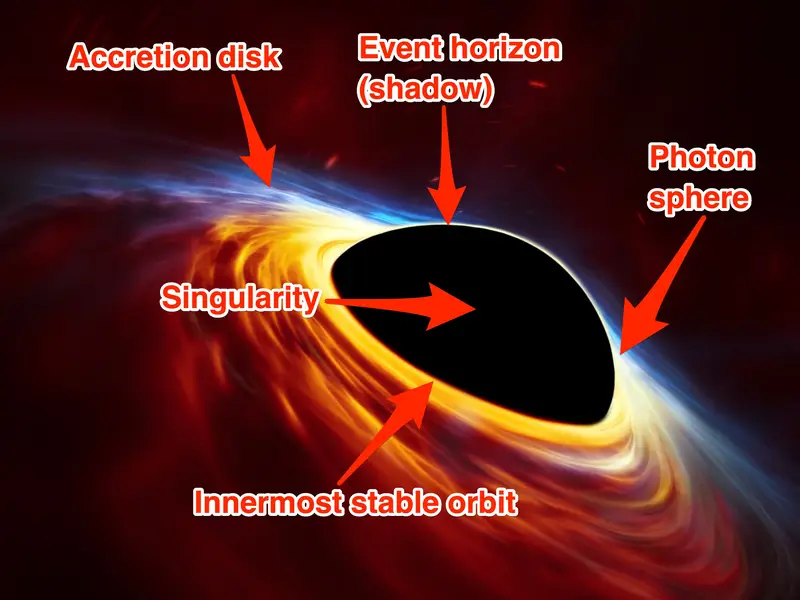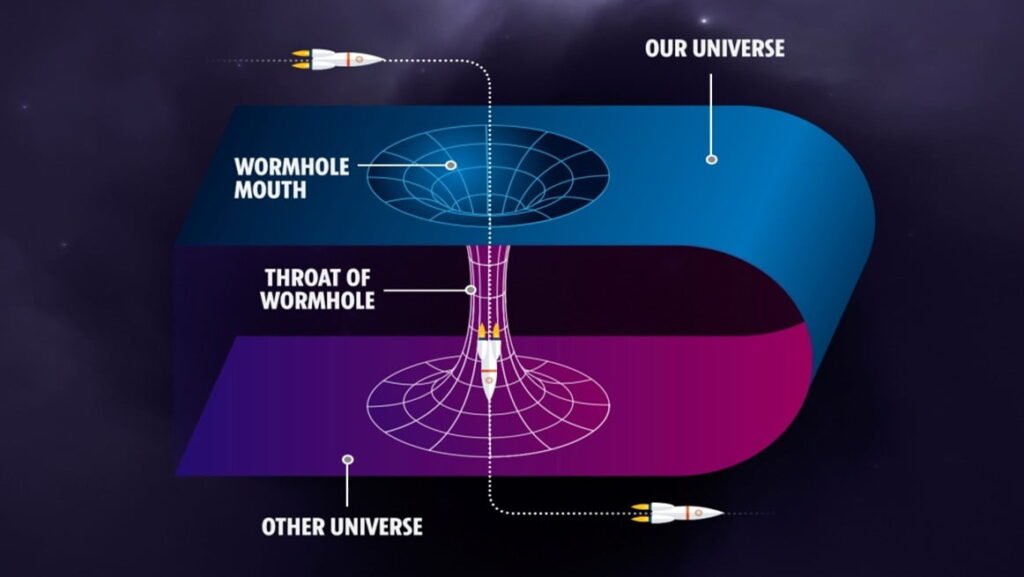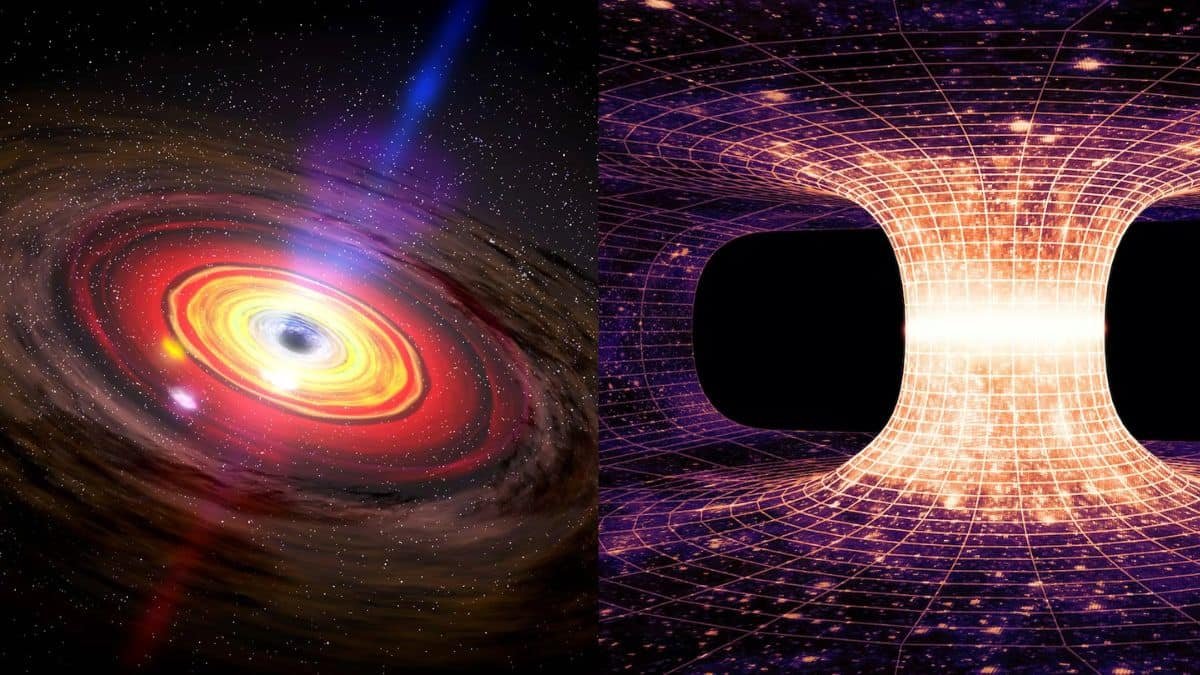A black hole as a cosmic vacuum cleaner that sucks in everything nearby, while a wormhole is like a secret tunnel that could potentially let you jump vast distances or even travel through time. It could even let you go to the another Universe within a very short time. That means through warm whole you can save your time. This is only happen theoretically.
Wormhole vs black hole: Before we jump to the difference between them let’s learn what actually a Black hole and the Warm hole means. The universe is a vast and mysterious place, filled with wonders that challenge our understanding of physics. Among these are wormholes and black holes, two fascinating yet vastly different cosmic phenomena.

Black Holes are regions in space where gravity is so strong that nothing, not even light, can escape from them. Let’s take a look at the picture just on your top. They are formed when massive stars collapse under their own gravity at the end of their life cycles. The boundary beyond which nothing can return is known as the event horizon.

Wormholes, on the other hand, are hypothetical tunnels through space-time, connecting two separate points in the universe. They are predicted by the theory of general relativity, and although we have not observed one, they remain a popular subject in science fiction and theoretical physics.
Wormhole vs black hole
| Feature | Wormhole | Black Hole |
|---|---|---|
| Nature | A wormhole is a hypothetical structure in space-time, often described as a tunnel that could connect two separate points in space and time. It is a concept arising from the theory of general relativity. | A black hole is a region in space where gravity is so strong that nothing, not even light, can escape from it. It results from the collapse of a massive star. |
| Formation | Wormholes are theoretical constructs. They have not been proven to exist and are primarily explored through mathematical models and theoretical physics. | Black holes form when a massive star exhausts its nuclear fuel and collapses under its own gravity, compressing matter to a point of infinite density known as a singularity. |
| Escape | Theoretically, if a wormhole exists and is traversable, it might allow passage from one end to the other, enabling travel between distant points in space. | Once something crosses the event horizon of a black hole, it cannot escape. The event horizon is the boundary beyond which the gravitational pull is so strong that escape is impossible. |
| Observation | Wormholes have not been observed. They remain purely speculative and are part of theoretical physics and science fiction. | Black holes have been observed indirectly. Their presence is inferred from the behavior of nearby objects, such as stars and gas clouds, and through gravitational waves and the detection of high-energy radiation emitted by the material as it is pulled into a black hole. |
| Purpose | In theory, wormholes could allow for rapid travel between distant parts of the universe, potentially serving as shortcuts through space-time. | Black holes are the end state of massive stars and have significant effects on their surroundings, including the bending of light and the alteration of space-time. They contribute to our understanding of gravity and the behavior of matter under extreme conditions. |
The Key Points of Black hole and the Warm hole
- Black Holes:
- Inescapable: Once past the event horizon, there is no return. Let me explain this briefly. The event horizon of a black hole is the boundary beyond which nothing, not even light, can escape its gravitational pull. It’s the point of no return. Once any form of matter or radiation crosses this threshold, it inevitably falls inward and cannot escape back into the universe. This is because the escape velocity (the speed needed to break free from a gravitational field) at the event horizon exceeds the speed of light, which is the cosmic speed limit. As nothing can travel faster than light, crossing the event horizon means being trapped forever by the black hole’s gravity. The event horizon is not a physical surface but an imaginary boundary marking the limits of a black hole’s influence.
- Singularity: At the center, where density becomes infinite. This means, At the heart of a black hole lies the singularity, a point where matter is thought to be infinitely dense and the laws of physics as we know them cease to apply. The singularity is where the black hole’s mass resides, and due to its immense gravity, space and time are predicted to become infinitely distorted. This concept challenges our understanding because our current theories cannot describe such extreme conditions. Infinities in physics usually indicate that the theory is incomplete. As such, singularities are a frontier in scientific research, with theories like quantum gravity attempting to understand the true nature of these enigmatic points. The singularity is hidden within the event horizon, making direct observation and study impossible with our current technology and understanding.
- Hawking Radiation: They emit radiation due to quantum effects. Hawking Radiation is a theoretical prediction that black holes emit radiation due to quantum effects near their event horizons. This phenomenon arises from the principles of quantum mechanics, which govern subatomic particles. In the vacuum of space, particle-antiparticle pairs constantly pop into and out of existence. Normally, they annihilate each other quickly, but at the event horizon, one particle may fall into the black hole while its partner escapes as radiation. This process leads to a net loss of mass for the black hole, as it effectively ‘radiates’ away energy. Over incredibly long timescales, this could result in the black hole evaporating entirely. Hawking Radiation reconciles the laws of quantum mechanics with gravity, suggesting that black holes are not eternal and can eventually dissipate.
- Wormholes:
- Exotic Matter: Requires matter with negative energy density to stay open. Wormholes are hypothetical tunnels in spacetime, predicted by Einstein’s theory of general relativity, that could create shortcuts for long journeys across the universe. The concept of a wormhole suggests two distant points connected by a stable throat, allowing matter to travel between them. For a wormhole to stay open, it requires exotic matter with negative energy density. This exotic matter would exert a repulsive force, countering the immense gravitational pull that would otherwise cause the wormhole to collapse instantly. Negative energy density is a strange and speculative concept, as it implies the existence of matter that defies our current understanding of energy conditions in physics. While exotic matter has not been observed, its theoretical properties are crucial for the possibility of stable wormholes, making them an intriguing subject for scientific and science fiction exploration alike.
- Time Travel: Theoretically could allow for time travel if one end moves relative to the other. Wormholes could theoretically enable time travel if one end of the wormhole is moved relative to the other. According to Einstein’s theory of relativity, time passes at different rates in different gravitational potentials; this is known as time dilation. If one mouth of a wormhole is in a strong gravitational field, or is moved at high speeds, time would pass differently from the other end. If someone were to travel through this wormhole, they could potentially emerge at an earlier or later time than when they entered, relative to the starting point. This concept is based on the idea that spacetime can be warped and connected in complex ways, allowing for paths that could circumvent the normal flow of time. However, this remains purely theoretical and speculative, as practical construction and stability of such a wormhole are beyond our current technological capabilities.
- Stability: Likely to collapse quickly without exotic matter. Here I’ve tried to discuss more: Wormholes are theorized to be incredibly unstable structures within spacetime. Without exotic matter, which possesses negative energy density, a wormhole would likely collapse so quickly that nothing could pass through it. The intense gravitational forces at play would naturally pull the wormhole shut, much like how a stretched elastic band snaps back to its original shape when released. Exotic matter is hypothesized to provide a repulsive force that counteracts this gravitational pull, propping the wormhole open and maintaining its stability. However, the existence of exotic matter and its properties are purely speculative and have not been confirmed by experimental evidence. The concept of using exotic matter for wormhole stability is a significant challenge in theoretical physics and remains a topic of active research and debate.
While black holes have been indirectly observed through their interaction with surrounding matter and gravitational waves, wormholes remain purely theoretical. If they do exist, they could revolutionize our understanding of the universe and enable interstellar travel. However, the technology and understanding required to harness or even observe wormholes are far beyond our current capabilities.
In conclusion, both wormholes and black holes captivate our imagination with their mysterious nature and potential implications for space travel and our understanding of the universe. As we continue to explore the cosmos, who knows what incredible discoveries await us?

